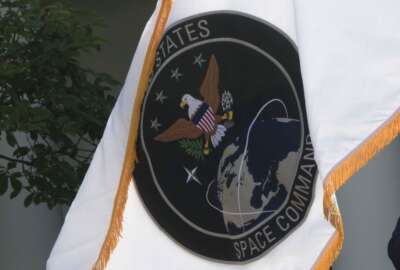The military’s new U.S. Space Command realizes the government is no longer the cutting-edge developer of space technologies, and it’s organizing itself accordingly so it can take advantage of top companies’ work.
The command, which is still getting its feet under it, created a Commercial Integration Cell (CIC) that focuses on maintaining strong interaction with commercial satellite owners and operators that provide services to the Defense Department, according to Maj. Gen. Stephen Whiting, SPACECOM combined force space component commander.
“With the CIC we can keep real-time and near-real-time information flowing between our military operations floors and the operations floors of eight companies,” he said last Friday during an Air Force Association event in Washington. “This allows informed responses during critical unplanned space events or during routine operations.”
To bolster that relationship, SPACECOM created a full-time military position within its combined force space component that will create follow-on agreements, codify procedures and explore growing a CIC-like entity into new space-mission areas.
“We are looking for ways to adapt the construct of CIC or look for multiple variations of it in order to best shape our operational relationships with the commercial sector,” Whiting said.
SPACECOM is also adapting so it can align with private space company business practices.
The command took a page from U.S. Special Operations Command and created Combat Development Divisions.
“They are small teams focused exclusively on scouting for new technologies and using them as quickly as possible,” Whiting said. “These divisions allow their commanders to mitigate the uncertainty of their highly volatile environment by posturing their organizations to be as fast and flexible as possible so they can always be the first to adapt to change.”
Whiting said they are already starting to see some returns on pilot programs involving the teams.
“They helped stand up the first dev/sec/ops platform in DoD,” Whiting said. “That means they helped launch DoD’s first development platform for building and hosting cloud-native military software applications.”
The teams also worked with space acquisition partners at Space and Missile Systems Center and the Air Force Research Laboratory and seeded money to several emerging space companies to mature technologies.
Space technology is in a much different place than during the Cold War. Back then, DoD and other government agencies held the reins to space access and innovation.
Now, those reins are in the hands of private companies like SpaceX.
“In the past 10 years alone, the number of space companies receiving private, nongovernment funding grew from 24 to more than 375,” Whiting said. “That’s a 1,500 percent increase in privately funded space organizations in only 17 percent of the time we have spent as a space-faring society.”
While more companies are adding competition and new advancements to the space realm, it changes the calm, predictable environment the U.S. is used to in the space marketplace.
“We have entered into a new space race, an entrepreneurial space race, and it has pulled our enterprise out of its predictable and comfortable state, and into one that is ambiguous, complex and highly unpredictable,” Whiting said.
That is why DoD is working hard to establish deep connections with private industry.
SPACECOM and Air Force Space Command chief Gen. John Raymond said he’s excited for the pairing of government and industry space capabilities.
Raymond said Monday during a speech at the Center for Strategic and International Studies that one area of collaboration will be using autonomous ranges that don’t need as much infrastructure.
“SpaceX, when they launch a rocket, they don’t use our radars,” Raymond said. “They don’t use our telemetry. They don’t use what we call command destruct antennas, which we have — antennas with people on console that if a missile were to start going astray they would send a signal to the rocket to blow it up. They do it all autonomously. That saves significant amount of dollars, and allows for a more rapid turnaround of the range.”
Copyright
© 2024 Federal News Network. All rights reserved. This website is not intended for users located within the European Economic Area.

